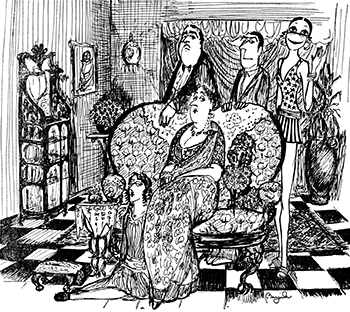Nothing minimalist about this
Berjis Desai
The salesperson of the real estate company expected squeals of delight from his potential customer, a pedigreed Parsi gent. The apartment on display, ready for moving in, was in minimalist style. Expensive Italian marble — Statuario Venato with Rosa Travertine cleverly contrasted; one sitting area had oddly contoured chairs from Milan (more for staring at, than sitting on); refurbished 1932 French sofas in blood red leather; electronically operated curtains slithering without a whisper; a delicate white marble top dining table surrounded by deceptively fragile looking chairs; very low snow white beds merging with
snow white walls. Too sleek, his customer sneered. He then volunteered to explain what constitutes quintessential Parsi furniture.
Marble is for mausoleums; the floor should be wooden or parquet. Art deco sofas, tastefully restored. Curtains should be lace; no need for extra clever gadgetry — in an office, maybe, not in a residence. The dining table late Victorian style in mahogany or red walnut with sturdy chairs with the solid base often ornately carved. The oak sideboard, also profusely carved, Jacobean (circa 1800) with its corniced top and thick set panel doors matching the dining table. Coffee to be served on the oval shaped rosewood oak table.
"My granduncle Pestonjee possessed the loveliest sofas,” elaborated the Parsi. In a corner of his living room, he had a French painted Louis XV style sofa with yellow floral tapestry and rather dainty arms and legs. Along with it was the Hepplewhite mahogany chair back settee, serpentine fronted. Though outwardly fragile looking, these two pieces did not creak under the weight of Pestonjee’s gargantuan spinster sister, whom food, and not thyroid, had rendered large.
Of course, the traditional Parsi easy chair (known as the fornicator), offering extendable wooden surfaces on which both pairs of arms and legs may unabashedly lounge, is a non-negotiable item. Parsi gentlemen of leisure, attired in
sudreh and
lengha, reclining at a
45 degree angle on the easy chair, their legs spread-eagled on the extensions, with the Jam-e-Jamshed in their hands (when it was not tabloid size), was a common sight. This posture was akin to the
pawanmuktasana (releasing
wind) in yoga and must have facilitated the dhansak laden digestive tracts to expel any noxious gas. Ancient solicitors can be seen snoozing on these easy chairs at the Ripon Club and the Petit Library even today.

Sketch by Manjula Padmanabhan
The traditional Parsi bedroom had huge mahogany four-poster beds made in the George III era (around 1800).The beds were covered with mosquito nets (
machhardani) at night to prevent any airborne creature from transgressing into
the space and were expertly folded during the day. One felt ensconced and safe in these four-poster beds which simulated the warmth and comfort of the mother’s womb. The ever popular George V’s (
aapro
paanchmo George) reign witnessed the manufacture of beds in art deco style, book matched burr walnut veneer, with fruitwood cross banding and inlaid mother of pearl detail. These beds were often brought by the Parsi bride as part of her dowry and became the lagan no
dholiyo. The beds were so comfortable that they induced instant sleep and were perhaps a contributory factor to our declining population.
Enormous
mid Victorian
ash chests with long drawers stored the linen and other home textiles of the Parsi household.
Nineteenth century pedestal wine tables were ideal at which to savor vintage port or cognac after dinner. Teetotallers used these tables to display bronze figurines. All very British; the Continent was, of course, for lesser mortals.
Talking of display items,
artefacts, carpets, grandfather clocks, pianos, vases, plates,
jugs and silver, would certainly require an entire column.
The community’s taste in furniture raises some interesting questions. Are we simply unable to shrug off the hangover of all things British or are we trapped in a time warp which prevents us from going modern and chic? Antique furniture reminds us of our days of glory, of our proximity to our English masters, of that feeling of inherent superiority over the lesser natives, of an era of exclusivity and pomp. A glorious past allays the fears of a not too bright future. One can sense grandpapa sitting in that easy chair and mother sipping her mid-morning coffee from that wine colored coffee table having that extraordinary patina. The modern and minimalist
is for the nouveau riche. We are, after all, the ancien régime.
One of our aristocratic Parsi lady clients had gifted us an antique rosewood kidney shaped table for our study with a green leather upholstered
chair, because her strained cash flow did not permit her to pay us a dime in fees.
At her opulent residence, we had seen an excellent Victorian burr walnut duchess dressing table (
mid Victorian period), made from solid walnut with walnut veneers. The oval shaped mirror, which swung back and forth, was rather small for our client’s large visage. She also possessed the quaintest
stools of all kinds, an obsession in many Parsi residences. The Queen Anne style stool with red upholstery, a pair of children’s stools, and of course, we must mention the adjustable revolving three-legged
piano stool with glass ball feet. The 12-inch diameter of the seat though was adequate only to house
one half of the abundant posterior of the noble lady while she played the German piano.
Berjis M. Desai,
senior partner of J. Sagar Associates,
advocates and solicitors, is a writer and community activist.
